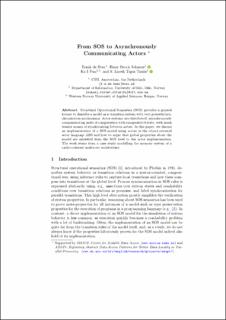| dc.contributor.author | de Boer, Frank | |
| dc.contributor.author | Johnsen, Einar Broch | |
| dc.contributor.author | Pun, Ka I | |
| dc.contributor.author | Tapia Tarifa, Silvia Lizeth | |
| dc.date.accessioned | 2021-02-22T12:00:28Z | |
| dc.date.available | 2021-02-22T12:00:28Z | |
| dc.date.created | 2020-09-28T12:08:24Z | |
| dc.date.issued | 2020 | |
| dc.identifier.citation | de Boer, F., Johnsen, E. B., Pun, K. I., & Tapia Tarifa, S. L. (2020). From SOS to asynchronously communicating actors. In J. Camara & M. Steffen (Eds.), Software engineering and formal methods (pp. 269-275). | en_US |
| dc.identifier.issn | 0302-9743 | |
| dc.identifier.uri | https://hdl.handle.net/11250/2729494 | |
| dc.description | This is an author's accepted manuscript version (postprint) of an article published by Springer in Lecture Notes in Computer Science on 10 September 2020. The final authenticated version is available online at https://doi.org/10.1007/978-3-030-57506-9_20 | en_US |
| dc.description.abstract | Structural Operational Semantics (SOS) provides a general format to describe a model as a transition system with very powerful synchronization mechanisms. Actor systems are distributed, asynchronously communicating units of computation with encapsulated state, with much weaker means of synchronizing between actors. In this paper, we discuss an implementation of a SOS model using actors in the object-oriented actor language ABS and how to argue that global properties about the model are inherited from the SOS level to the actor implementation. The work stems from a case study modelling the memory system of a cache-coherent multicore architecture. | en_US |
| dc.language.iso | eng | en_US |
| dc.publisher | Springer | en_US |
| dc.title | From SOS to asynchronously communicating actors | en_US |
| dc.type | Peer reviewed | en_US |
| dc.type | Journal article | en_US |
| dc.description.version | acceptedVersion | en_US |
| dc.source.pagenumber | 269-275 | en_US |
| dc.source.volume | 12226 | en_US |
| dc.source.journal | Lecture Notes in Computer Science (LNCS) | en_US |
| dc.identifier.doi | 10.1007/978-3-030-57506-9_20 | |
| dc.identifier.cristin | 1834156 | |
| dc.relation.project | Norges forskningsråd: 237898 | en_US |
| dc.relation.project | Norges forskningsråd: 274515 | en_US |
| cristin.ispublished | true | |
| cristin.fulltext | original | |
| cristin.qualitycode | 1 | |
